Nylon is an interesting fiber completely man-made. Nylon was in vented in 1935 by Wallace Carothers who worked for Du-Pont. It hit the markets in 1939 and was an instant hit, especially as a replacement for silk in hosiery. Carothers never got to see the impact that his invention made on society. He died in April, 1937.
Nylon is a synthetic fabric made from petroleum products( so it’s not very Eco-friendly). It was developed as an alternative to silk, although it quickly became unavailable to civilian consumers, because nylon was used extensively during the war. Nylon is valued for its light weight, incredible tensile strength, durability, and resistance to damage( great for socks of course). It also takes dye easily, making nylon fabrics available in a wide array of colors for consumers.
Today, nylon is among the many polymer products in common daily use throughout the world. It is the second most used fiber in the United States, since it is so versatile and relatively easy to make. Like most petroleum products, it has a very slow decay rate, which unfortunately results in the accumulation of exhausted nylon products in landfills around the world (hmmm wondering if we should be using this product).
Nylon is produced by a melt spinning method. Basically the nylon is melted and run into a spinneret and then cooled to solidify it. By using different shaped spinnerets octagonal,pentagonal, trilobal etc, it create different effects such as a matt look or a glittery look some shapes hide dirt well (hence why nylon is used for carpeting). Here is an entire diagram of how it is made starting with crude oil.
I found 3 separate types of nylon spinning fiber(there may be more). The ones I found are blending nylon, what you would use in socks, Icicle made by Louet it has some shine , and firestar which is the most shiny of all. All the fiber is dyeable with acid dyes.
Top blending nylon, middle icicle fiber, bottom firestar(hard to capture shine on this one, actually the shiniest)
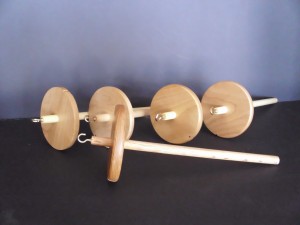 In store news we have new spindles being added to the store this week.
In store news we have new spindles being added to the store this week.

This is Teddy. He had a pluck this week. In the background you can see his tote of fiber.
I have a basket full of fiber left from combing top. I’ll do a random drawing for everyone who likes “the fiber of my being” facebook page and comments below. Contest ends April 14 midnight the winner will be drawn by random number generator and posted in Friday’s blog post.
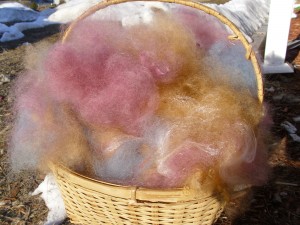
Disclaimer: Fiber is seconds from 8in long coopworth combings..while not 8 inches it will have a pretty good staple. There may a bit of veggie matter in this. There may also be a few neps. I would normally card this fiber into batts as there is really nothing wrong with it.
P.S. The fiber weights 3 3/8 oz.
P.P.S. The new video for the “From Llama to Shawl/Scarf” has been postponed until next week. I have a few personal things to take care of. Thanks for your understanding.
Tags: angora, angora fiber for sale, angora fiber price, angora rabbit fiber, angora rabbits, animal rescue, animals rescue maine, contest, free fiber, freebie fiber, nylon fiber, nylon spinning fiber, nylon yarn, raising fiber animals, where nylon comes from, wool for spinning for sale, wool for spinning yarn, wool processing
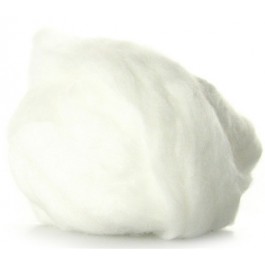
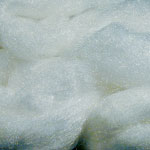
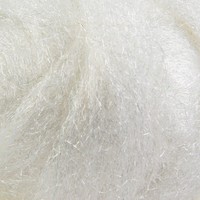










Hi, Brandi. Your post about nylon is very interesting and informative. I guess all of us prefer natural fibers, but you’ve got to have a little nylon if you want your socks to last. I don’t think I’m going to guilt myself over it. 🙂
I’m sure you’ve seen atomic clocks. They brag on their packaging that they’re linked to a government timekeeping transmitter. According to Wikipedia, the clocks and watches aren’t technically atomic clocks, but they receive transmissions from a facility that does have an atomic clock. ” A radio clock is a clock that automatically synchronizes itself by means of government radio time signals received by a radio receiver. Many retailers market radio clocks inaccurately as atomic clocks; although the radio signals they receive originate from atomic clocks, they are not atomic clocks themselves. They are inexpensive time-keeping devices with an accuracy of about a second. Instrument grade time receivers provide higher accuracy. Such devices incur a transit delay of approximately 1 ms for every 300 kilometres (186 mi) of distance from the radio transmitter. Many governments operate transmitters for time-keeping purposes.” So, anyway, the watch picks up a radio signal several times a day and resets itself if it gets out of synch. It also resets itself for daylight savings time and if you travel to a new time zone. The solar part is just a solar cell that recharges a solar battery when you expose it to light. That way, you should never have to replace the battery.
I don’t know whether an atomic watch would work better for you or not. I’ve known several people who couldn’t wear a watch due to a high personal electrical field. My Mom used to wear a watch pendant or brooch to avoid wearing a watch on her wrist and that seemed to help the problem.
Nowdays, watches themselves are a little anacronistic. Everyone carries a cell phone and that has the time on it. 🙂
I like wearing a watch. I hate digging out my cell phone just to see what time it is. I was wondering if it might be like a kinetic watch. I’m not going to guilt myself either over the little bit of nylon but who knew it was that bad.
Thanks for the very informative article about nylon, Brandi. It sure isn’t ecologically friendly, is it? But it sure comes in handy in sock yarns, doesn’t it? Will you be doing articles about such things as acrylic and polyester–or have you done them, and I just haven’t seen them?
Hazel
I haven’t done acrylic and polyester but I do plan on it:)